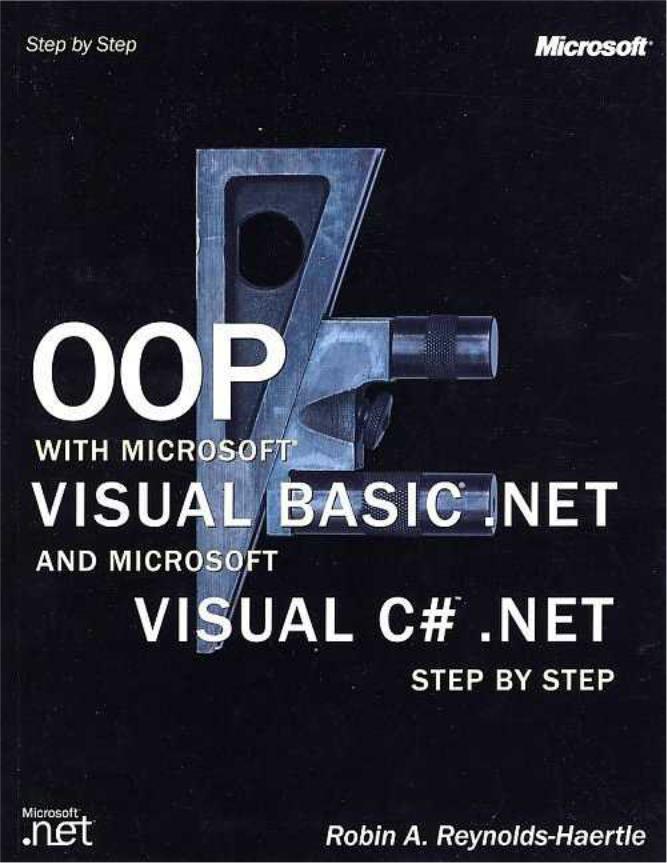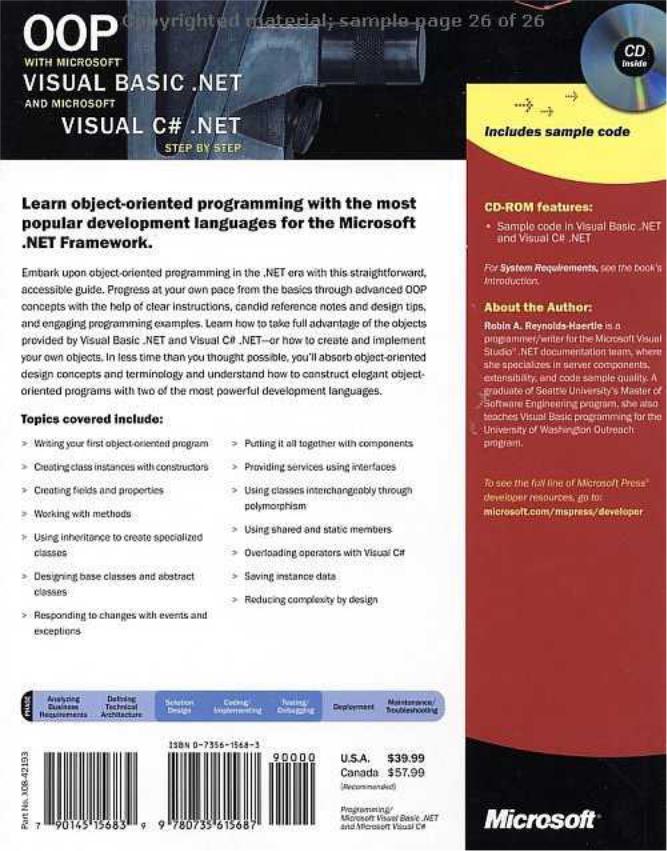
C# ПІДРУЧНИКИ / c# / MS Press - Oop With MS Vb Net And C# Step By Step (2002)
.pdf


OOP with Microsoft Visual Basic .NET and Microsoft Visual C# Step by Step
by Robin A. Reynolds-Haertle Microsoft Press © 2002 (393 pages)
This intuitive, self-paced learning title is designed to help you master the basics of object-oriented programming with Visual Basic.NET or Visual C#.
Table of Contents
OOP with Microsoft Visual Basic .NET and Microsoft Visual C# .NET Step by Step
Introduction
Chapter 1 - Writing Your First Object-Oriented Program
Chapter 2 - Creating Class Instances with Constructors
Chapter 3 - Creating Fields and Properties
Chapter 4 - Working with Methods
Chapter 5 - Using Inheritance to Create Specialized Classes
Chapter 6 - Designing Base Classes as Abstract Classes
Chapter 7 - Responding to Changes with Events and Exceptions
Chapter 8 - Putting It All Together with Components
Chapter 9 - Providing Services Using Interfaces
Chapter 10 - Using Classes Interchangeably Through Polymorphism
Chapter 11 - Using Shared and Static Members
Chapter 12 - Overloading Operators with Visual C#
Chapter 13 - Saving Instance Data
Chapter 14 - Reducing Complexity by Design
Appendix - Additional Resources
Index
Height Gage
List of Sidebars
OOP with Microsoft Visual Basic .NET and Microsoft Visual C# .NET Step by Step
PUBLISHED BY
Microsoft Press
A Division of Microsoft Corporation
One Microsoft Way
Redmond, Washington 98052-6399
Copyright © 2002 by Robin A. Reynolds-Haertle
All rights reserved. No part of the contents of this book may be reproduced or transmitted in any form or by any means without the written permission of the publisher.
Library of Congress Cataloging-in-Publication Data Reynolds-Haertle, Robin A., 1959-
OOP with Microsoft Visual Basic .NET and Microsoft Visual C# Step by Step / Robin A. Reynolds-Haertle.
p. cm.
Includes bibliographical references and index.
ISBN 0-7356-1568-3
1. Object-oriented programming (Computer science). 2. Microsoft Visual BASIC. 3. C# (Computer program language) I. Title.
QA76.64 .R495 2001 005.2’768—dc21 2001052122
Printed and bound in the United States of America.
1 2 3 4 5 6 7 8 9 QWT 7 6 5 4 3 2
Distributed in Canada by Penguin Books Canada Limited.
A CIP catalogue record for this book is available from the British Library.
Microsoft Press books are available through booksellers and distributors worldwide. For further information about international editions, contact your local Microsoft Corporation office or contact Microsoft Press International directly at fax (425) 936-7329. Visit our Web site at www.microsoft.com/mspress. Send comments to: mspinput@microsoft.com. IntelliSense, Microsoft, Microsoft Press, Visual Basic, Visual C#, Visual Studio, and Windows are either registered trademarks or trademarks of Microsoft Corporation in the United States and/or other countries. Other product and company names mentioned herein may be the trademarks of their respective owners.
The example companies, organizations, products, domain names, e-mail addresses, logos, people, places, and events depicted herein are fictitious. No association with any real company, organization, product, domain name, e-mail address, logo, person, place, or event is intended or should be inferred.
Acquisitions Editor: Danielle Bird Project Editor: Kathleen Atkins Technical Editor: Jack Beaudry
Body Part No. X08-42192
MICROSOFT LICENSE AGREEMENT
Book Companion CD
IMPORTANT—READ CAREFULLY: This Microsoft End-User License Agreement (“EULA”) is a legal agreement between you (either an individual or an entity) and Microsoft Corporation for the Microsoft product identified above, which includes computer software and may include associated media, printed materials, and “online” or electronic documentation (“SOFTWARE PRODUCT”). Any component included within the SOFTWARE PRODUCT that is accompanied by a separate End-User License Agreement shall be governed by such agreement and not the terms set forth below. By installing, copying, or otherwise using the SOFTWARE PRODUCT, you agree to be bound by the terms of this EULA. If you do not agree to the terms of this EULA, you are not authorized to install, copy, or otherwise use the SOFTWARE PRODUCT; you may, however, return the SOFTWARE PRODUCT, along with all printed materials and other items that form a part of the Microsoft product that includes the SOFTWARE PRODUCT, to the place you obtained them for a full refund.
Software PRODUCT LICENSE
The SOFTWARE PRODUCT is protected by United States copyright laws and international copyright treaties, as well as other intellectual property laws and treaties. The SOFTWARE PRODUCT is licensed, not sold.
1. GRANT OF LICENSE. This EULA grants you the following rights:
a. Software Product. You may install and use one copy of the SOFTWARE PRODUCT on a single computer. The primary user of the computer on which the SOFTWARE PRODUCT is installed may make a second copy for his or her exclusive use on a portable computer.
b. Storage/Network Use. You may also store or install a copy of the SOFTWARE PRODUCT on a storage device, such as a network server, used only to install or run the SOFTWARE PRODUCT on your other computers over an internal network; however, you must acquire and dedicate a license for each separate computer on which the
SOFTWARE PRODUCT is installed or run from the storage device. A license for the SOFTWARE PRODUCT may not be shared or used concurrently on different computers. c. License Pak. If you have acquired this EULA in a Microsoft License Pak, you may make the number of additional copies of the computer software portion of the SOFTWARE PRODUCT authorized on the printed copy of this EULA, and you may use each copy in the manner specified above. You are also entitled to make a corresponding number of secondary copies for portable computer use as specified above.
d. Sample Code. Solely with respect to portions, if any, of the SOFTWARE PRODUCT that are identified within the SOFTWARE PRODUCT as sample code (the “SAMPLE CODE”):
i.Use and Modification. Microsoft grants you the right to use and modify the source code version of the SAMPLE CODE, provided you comply with subsection (d)(iii) below. You may not distribute the SAMPLE CODE, or any modified version of the SAMPLE CODE, in source code form.
ii.Redistributable Files. Provided you comply with subsection (d)(iii) below, Microsoft grants you a nonexclusive, royalty-free right to reproduce and distribute the object code version of the SAMPLE CODE and of any modified SAMPLE CODE, other than
SAMPLE CODE, or any modified version thereof, designated as not redistributable in the Readme file that forms a part of the SOFTWARE PRODUCT (the “Non-Redistributable Sample Code”). All SAMPLE CODE other than the Non-Redistributable Sample Code is collectively referred to as the “REDISTRIBUTABLES.”
iii. Redistribution Requirements. If you redistribute the REDISTRIBUTABLES, you agree to: (i) distribute the REDISTRIBUTABLES in object code form only in conjunction with and as a part of your software application product; (ii) not use Microsoft’s name, logo, or trademarks to market your software application product; (iii) include a valid copyright notice on your software application product; (iv) indemnify, hold harmless, and defend Microsoft from and against any claims or lawsuits, including attorney’s fees, that arise or result from the use or distribution of your software application product; and
(v) not permit further distribution of the REDISTR IBUTABLES by your end user. Contact Microsoft for the applicable royalties due and other licensing terms for all other uses and/or distribution of the REDISTRIBUTABLES.
2. DESCRIPTION OF OTHER RIGHTS AND LIMITATIONS.
• Limitations on Reverse Engineering, Decompilation, and Disassembly. You may not reverse engineer, decompile, or disassemble the SOFTWARE PRODUCT, except and only to the extent that such activity is expressly permitted by applicable law notwithstanding this limitation.
•Separation of Components. The SOFTWARE PRODUCT is licensed as a single product. Its component parts may not be separated for use on more than one computer.
•Rental. You may not rent, lease, or lend the SOFTWARE PRODUCT.
•Support Services. Microsoft may, but is not obligated to, provide you with support services related to the SOFTWARE PRODUCT (“Support Services”). Use of Support
Services is governed by the Microsoft policies and programs described in the user manual, in “online” documentation, and/or in other Microsoft-provided materials. Any supplemental software code provided to you as part of the Support Services shall be considered part of the SOFTWARE PRODUCT and subject to the terms and conditions of this EULA. With respect to technical information you provide to Microsoft as part of the Support Services, Microsoft may use such information for its business purposes, including for product support and development. Microsoft will not utilize such technical information in a form that personally identifies you.
• Software Transfer. You may permanently transfer all of your rights under this EULA, provided you retain no copies, you transfer all of the SOFTWARE PRODUCT (including all component parts, the media and printed materials, any upgrades, this EULA, and, if applicable, the Certificate of Authenticity), and the recipient agrees to the terms of this EULA.
• Termination. Without prejudice to any other rights, Microsoft may terminate this EULA if you fail to comply with the terms and conditions of this EULA. In such event, you must destroy all copies of the SOFTWARE PRODUCT and all of its component parts.
3. COPYRIGHT. All title and copyrights in and to the SOFTWARE PRODUCT (including but not limited to any images, photographs, animations, video, audio, music, text, SAMPLE CODE, REDISTRIBUTABLES, and “applets” incorporated into the
SOFTWARE PRODUCT) and any copies of the SOFTWARE PRODUCT are owned by Microsoft or its suppliers. The SOFTWARE PRODUCT is protected by copyright laws and international treaty provisions. Therefore, you must treat the SOFTWARE PRODUCT like any other copyrighted material except that you may install the SOFTWARE PRODUCT on a single computer provided you keep the original solely for backup or archival purposes. You may not copy the printed materials accompanying the SOFTWARE PRODUCT.
4. U.S. GOVERNMENT RESTRICTED RIGHTS. The SOFTWARE PRODUCT and documentation are provided with RESTRICTED RIGHTS. Use, duplication, or disclosure by the Government is subject to restrictions as set forth in subparagraph (c)(1)(ii) of the Rights in Technical Data and Computer Software clause at DFARS 252.227-7013 or subparagraphs (c)(1) and (2) of the Commercial Computer Software—Restricted Rights at 48 CFR 52.227-19, as applicable. Manufacturer is Microsoft Corporation/One Microsoft Way/Redmond, WA 98052-6399.
5. EXPORT RESTRICTIONS. You agree that you will not export or re-export the SOFTWARE PRODUCT, any part thereof, or any process or service that is the direct product of the SOFTWARE PRODUCT (the foregoing collectively referred to as the “Restricted Components”), to any country, person, entity, or end user subject to U.S. export restrictions. You specifically agree not to export or re-export any of the Restricted Components (i) to any country to which the U.S. has embargoed or restricted the export of goods or services, which currently include, but are not necessarily limited to, Cuba, Iran, Iraq, Libya, North Korea, Sudan, and Syria, or to any national of any such country, wherever located, who intends to transmit or transport the Restricted Components back to such country; (ii) to any end user who you know or have reason to know will utilize the Restricted Components in the design, development, or production of nuclear, chemical, or biological weapons; or (iii) to any end user who has been prohibited from participating in U.S. export transactions by any federal agency of the U.S. government. You warrant and represent that neither the BXA nor any other U.S. federal agency has suspended, revoked, or denied your export privileges.
DISCLAIMER OF WARRANTY
NO WARRANTIES OR CONDITIONS. MICROSOFT EXPRESSLY DISCLAIMS ANY WARRANTY OR CONDITION FOR THE SOFTWARE PRODUCT. THE SOFTWARE PRODUCT AND ANY RELATED DOCUMENTATION are PROVIDED “AS IS” WITHOUT WARRANTY OR CONDITION OF ANY KIND, EITHE R EXPRESS OR IMPLIED, INCLUDING, WITHOUT LIMITATION, THE IMPLIED WARRANTIES OF MERCHANTABILITY, FITNESS FOR A PARTICULAR PURPOSE, OR NONINFRINGEMENT. THE ENTIRE RISK ARISING OUT OF USE OR PERFORMANCE OF THE SOFTWARE PRODUCT REMAINS WITH YOU. LIMITATION OF LIABILITY. TO THE MAXIMUM EXTENT PERMITTED BY APPLICABLE LAW, IN NO EVENT SHALL MICROSOFT OR ITS SUPPLIERS BE LIABLE FOR ANY SPECIAL, INCIDENTAL, INDIRECT, OR CONSEQUENTIAL DAMAGES WHATSOEVER (INCLUDING, WITHOUT LIMITATION, DAMAGES FOR LOSS OF BUSINESS PROFITS, BUSINESS INTERRUPTION, LOSS OF BUSINESS INFORMATION, OR ANY OTHER PECUNIARY LOSS) ARISING OUT OF THE USE OF OR INABILITY TO USE THE SOFTWARE PRODUCT OR THE PROVISION OF OR FAILURE TO PROVIDE SUPPORT SERVICES, EVEN IF MICROSOFT HAS BEEN ADVISED OF THE POSSIBILITY OF SUCH DAMAGES. IN ANY CASE, MICROSOFT’S ENTIRE LIABILITY UNDER ANY PROVISION OF THIS EULA SHALL BE LIMITED TO THE GREATER OF THE AMOUNT ACTUALLY PAID BY YOU FOR THE SOFTWARE PRODUCT OR US$5.00; PROVIDED, HOWEVER, IF YOU HAVE ENTERED INTO A MICROSOFT SUPPORT SERVICES AGREEMENT, MICROSOFT’S ENTIRE LIABILITY REGARDING SUPPORT SERVICES SHALL BE GOVERNED BY THE TERMS OF THAT AGREEMENT. BECAUSE SOME STATES AND JURISDICTIONS DO NOT ALLOW THE EXCLUSION OR LIMITATION OF LIABILITY, THE ABOVE LIMITATION MAY NOT APPLY TO YOU.
MISCELLANEOUS
This EULA is governed by the laws of the State of Washington USA, except and only to the extent that applicable law mandates governing law of a different jurisdiction.
Should you have any questions concerning this EULA, or if you desire to contact Microsoft for any reason, please contact the Microsoft subsidiary serving your country, or write: Microsoft Sales Information Center/One Microsoft Way/Redmond, WA 980526399.
PN 097-0002296
For Bruce
You’re still the one.
About the Author
Robin A. Reynolds-Haertle
Robin’s interest in computing began when she taught herself to program in C to fulfill a programming language requirement for her master’s degree in biomathematics at the University of Washington. Fascinated by the subject, Robin attended as many computer science classes as her schedule would permit, and took a position as a programmer with the University of Washington after graduation. Robin spent several years in the biotechnology industry, writing data applications in various database management systems, C, and Microsoft Visual Basic. Not content to just read computer science and software engineering books, she then pursued and completed a master’s degree in software engineering at Seattle University. During these years, Robin presented training sessions on software engineering topics to her peers. After so many years in the classroom, Robin wanted to try teaching, and jumped at the opportunity to teach objectoriented programming with Visual Basic for the University of Washington Outreach program. Here she discovered she loved writing instructional materials and sample projects for her students. This led Robin to her current position as a programmer/writer at Microsoft, writing conceptual documentation for Visual Basic and Microsoft Visual C#.
When not at the computer, Robin is trying to make peace with her abandoned husband and sons. After she completes this book, they look forward to Mom’s attention to Cub Scouts, Boy Scouts, hiking, and watching BattleBots. After catching up with the family, Robin hopes to sew a few quilts.
Acknowledgments
First I’d like to thank the team at Microsoft Press that turned my writing into a book. Without Jack Beaudry, the technical editor, I never would have gotten any sleep. His meticulous reviews saved me time and saved readers from much frustration. Kathleen Atkins, the project editor, kept everything running smoothly and improved my text considerably. Credit is also due to Danielle Bird, acquisitons editor; Rebecca McKay (Becka), manuscript editor; Cheryl Penner and Rebecca Wendling (Becky), copy editors; Gina Cassill, compositor; and Michael Kloepfer, electronic artist.
I also want to thank my colleagues at Microsoft who listened sympathetically to my complaints about deadlines and beta software. Editors Roger Haight and Meredith Waring made me a better writer. Mike Pope reminded me to put the reader ahead of being clever. Megan Shult and Ann Morris, my managers, were supportive even when writing consumed all my after-hours energy. Much of what I learned about .NET came from the material written by my team members Jina Chan, Seth Grossman, Steve Hoag, Steve Stein, and Matt Stoecker. And thank you to Diana Rain, my office mate.
I’d also like to thank Ruth McBride, my longtime manager, and my instructors at Seattle University. I appreciate their patience with my often experimental approaches to their assignments over the years.
I also have to mention the friends that still call to check on me, even though I haven’t called them in months. Jennifer Wirt, Lisa Wiken, Molly Potteiger, and Julie Brinkley have been true friends.
This book would never have been written without the support of my husband, Bruce. He completely ran my life for the seven months I was writing this book. I worked and wrote; he did everything else. My friends are still laughing about how he RSVPs for me. Lastly, I thank my sons for just being there and for being proud of me.

Introduction
Microsoft Visual Basic developers have long clamored for complete objectoriented language support. Microsoft Visual Basic .NET supports all the features of an objectoriented language. In addition, the entire Microsoft .NET Framework, which includes the development support for Microsoft Windows applications, Web applications, Web services, graphics, and data access, is designed according to object-oriented principles. Developers who have a firm grasp of object-oriented principles will be the strongest .NET developers.
Also new to developers is C#, a C-based language that gives developers a language choice for developing with the .NET Framework. Some C, Java, and C++ development will move to C# to take advantage of .NET’s features. Visual Basic programmers looking to learn a C language might also move to C#. Visual Basic .NET and C# both support object-oriented development with the .NET Framework. No matter what language you choose for development, being able to read code in either language will double your access to Microsoft Visual Studio documentation, .NET books, magazine articles, and other developer resources.
System Requirements
You’ll need the following hardware and software to complete the exercises in this book: § Microsoft Visual Studio .NET Professional edition. The Visual Studio .NET
software isn’t included with this book. You must purchase it separately and install it before you can complete the exercises in this book.
§ A computer capable of running Microsoft Visual Studio .NET. The following hardware configuration is recommended by the Microsoft Visual Studio .NET Web site, at http://msdn.microsoft.com/vstudio/nextgen/
Computer/Processor
PC with a Pentium II–class processor, 450 megahertz (MHz); Pentium III–class processor, 600 MHz recommended
Operating System
Microsoft Windows 2000, Server or Professional
Microsoft Windows XP Home or Professional
Microsoft Windows NT 4.0 Server
Memory
Windows 2000 Professional, 96 megabytes (MB) of RAM; 128 MB recommended
Windows 2000 Server, 192 MB of RAM; 256 MB recommended
Windows XP Professional, 128 MB of RAM; 160 Recommended
Hard Disk
500 MB on System Drive and 3.0 gigabyte (GB) on installation drive
Drive
CD-ROM drive
Display
VGA or higher–resolution monitor

Computer/Processor
Input Device
Microsoft Mouse or compatible pointing device
Finding Your Best Starting Point
This book is designed to teach you the fundamentals of object-oriented programming. You can use this book if you have a basic knowledge of Visual Basic 6, Visual Basic
.NET, Visual C#, or another Windows programming language. The exercises in this book assume you can already perform the following tasks:
§Create a new Windows Application project, build it, and run it.
§Add Windows Forms controls to a Windows Form.
§Create a method to respond to the Click event of a Button control.
§Create a simple method (called a Sub or Function in Visual Basic .NET).
§Declare and use variables.
For an introduction to Visual Basic .NET, read Microsoft Visual Basic .NET Step by Step by Michael Halvorson (Microsoft Press, 2002). For an introduction to Visual C# , read Microsoft Visual C# .NET Step by Step by John Sharp and Jon Jagger (Microsoft Press, 2002).
Use the following table to find your best starting point in this book.
If you are
New
To objectoriented programming
Migrating
Follow these steps
Install the practice files as described in the
following section, “Installing and Using the Practice Files”
Work through the chapters sequentially for a complete introduction to object-oriented programming. Chapters 1 through 7, 9, and 11 concentrate on the mechanics of objectoriented programming, while the other chapters cover the concepts in
more depth.
From Visual
Basic 6
Switching
From another objectoriented programming
Install the practice files as described in “Installing and Using the Practice Files” on the next page.
Work through the chapters sequentially for a complete introduction to objectoriented programming with Visual Basic
.NET. Chapters 1 through 7, 9, and 11 concentrate on the mechanics of objectoriented programming, while the other chapters cover the concepts in more depth.
Install the practice files as described in “Installingand Using the Practice Files.”
|
|
|
|
|
|
If you are |
|
Follow these steps |
|
|
|
|
|
|
|
New |
|
|
|
|
|
|
|
|
|
|
|
|
|
|
language. |
|
|
|
|
|
|
|
|
|
|
|
Complete Chapter 1 to learn the basic |
|
|
|
|
syntax of properties and methods. |
|
|
|
|
|
|
|
|
|
Read the Quick Reference sections at |
|
|
|
|
the end of the chapters for information |
|
|
|
|
about specific class constructs. |
|
|
|
|
|
|
|
Referencing |
|
|
|
|
|
|
|
|
|
|
|
|
|
|
The book |
|
Use the index or the Table of Contents |
|
|
|
to find information about particular |
|
|
|
after working |
|
|
|
|
|
subjects. |
|
|
|
through the |
|
|
|
|
|
|
|
|
|
exercises |
|
|
|
|
|
|
|
|
|
|
|
Read the Quick Reference at the end of |
|
|
|
|
each chapter to find a brief review of the |
|
|
|
|
syntax and techniques presented in the |
|
|
|
|
chapter. |
|
|
|
|
|
|
Installing and Using the Practice Files
The companion CD inside the back cover of this book contains the practice files that you’ll use as you perform the exercises in the book. For example, when you’re learning to create class events, you’ll use a bitmap file named Train.bmp. By using the practice files, you won’t waste time creating objects that aren’t relevant to the exercise. Instead, you can concentrate on learning object-oriented programming with Visual Basic .NET and Visual C# .NET. The files and the step-by-step instructions in the lessons also let you learn by doing, which is an easy and effective way to acquire and remember new skills.
Important |
Before you break the seal on the OOP with Microsoft Visual |
|
Basic .NET and Microsoft Visual C# Step by Step companion |
|
CD package, be sure that this book matches your version of |
|
the software. This book is designed for use with Microsoft |
|
Visual Studio .NET Professional Edition for the Windows |
|
operating systems. To find out what software you’re running, |
|
you can check the product package or you can start the |
|
software, and then click About Microsoft Development |
|
Environment in the Help menu at the top of the screen. |
Install the practice files |
|
Follow these steps to install the practice files on your computer’s hard disk so that you can use them with the exercises in this book.
1.Remove the companion CD from the package inside the back cover of this book and insert the CD in your CD-ROM drive.
2.Double-click the My Computer icon on the Desktop.
Tip
3.
4.
5.
On some computers, the startup program might run automatically when you close the CD-ROM drive. In this case, skip steps 2 through 5 and follow the instructions on the screen.
Double-click the icon for your CD-ROM drive. Double-click StartCD.exe
Click Install Sample Code.
